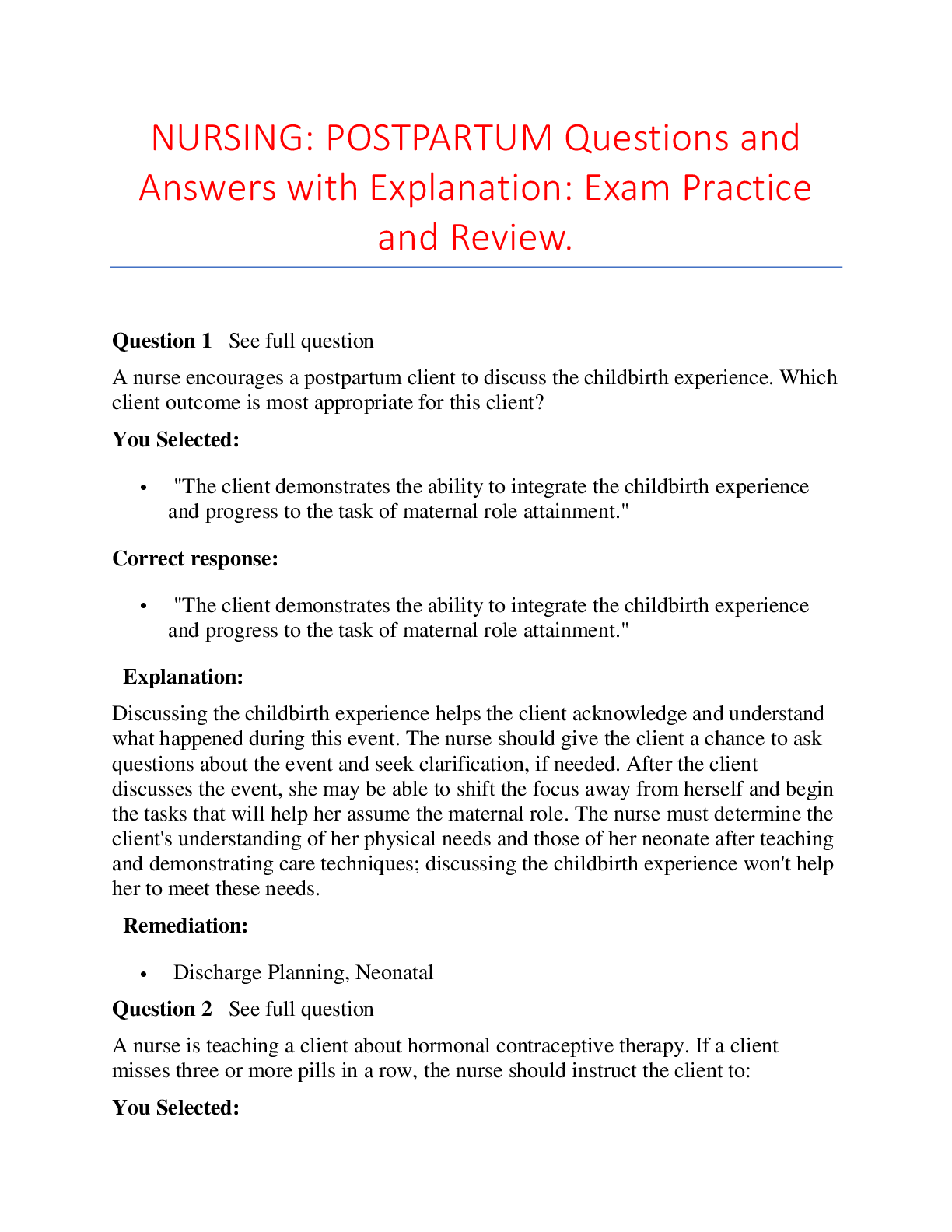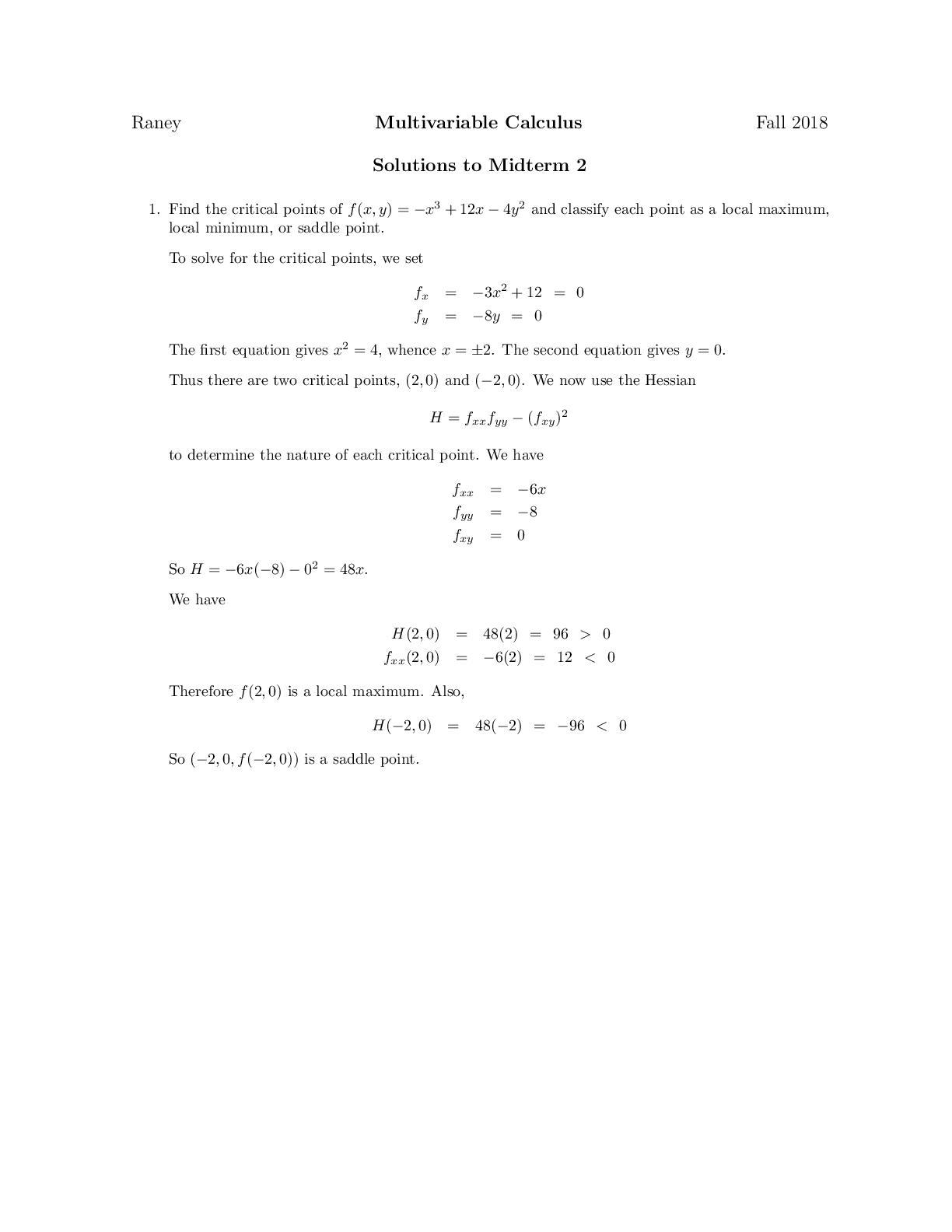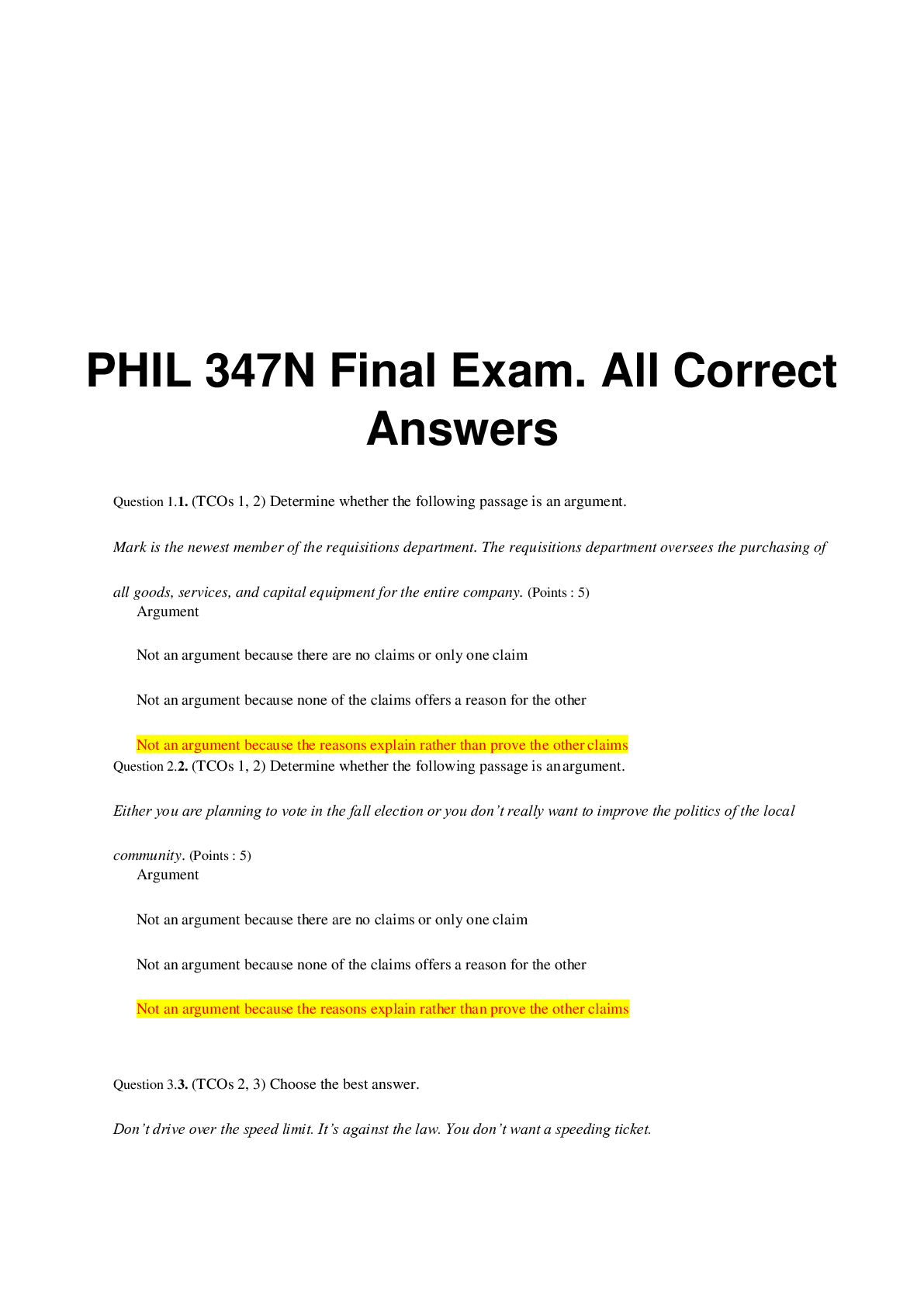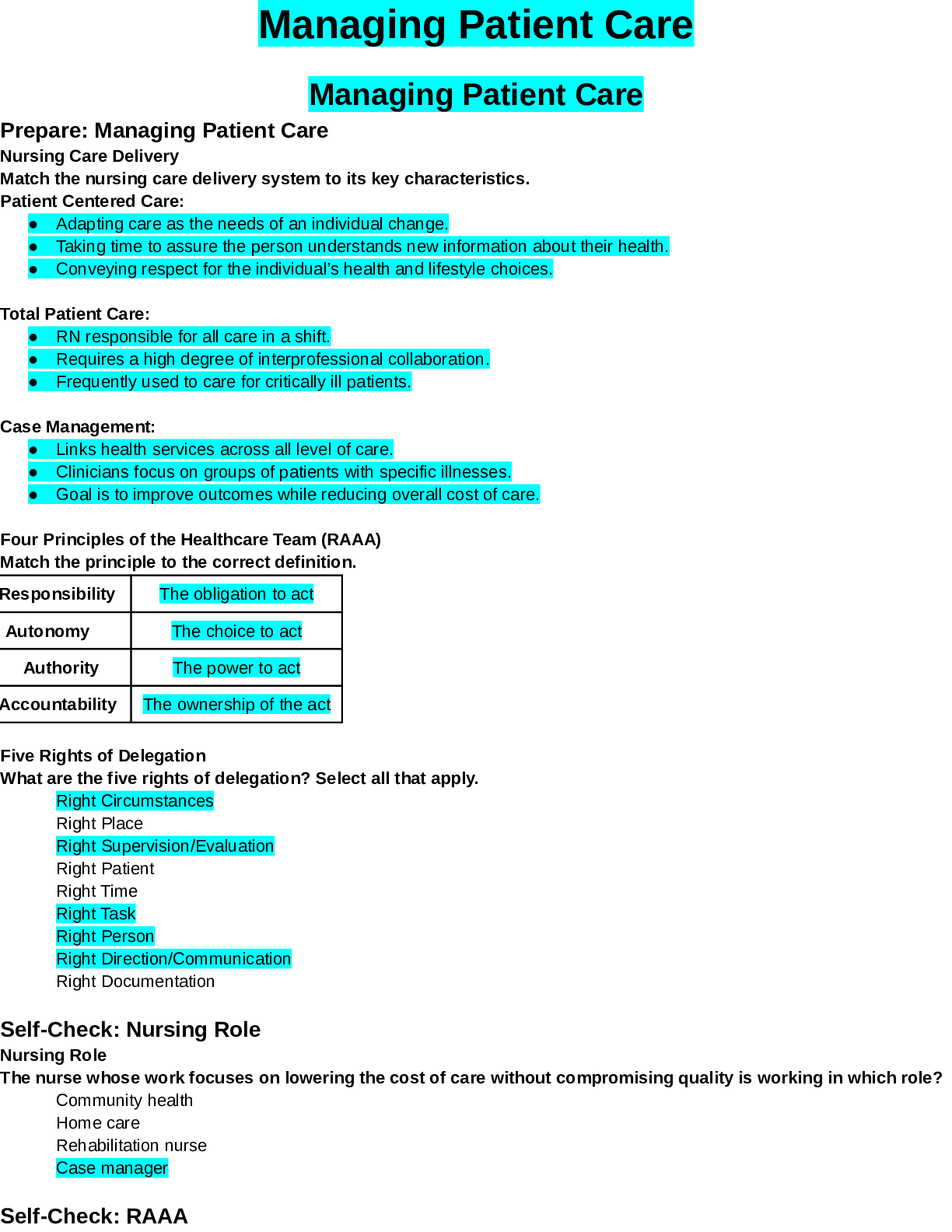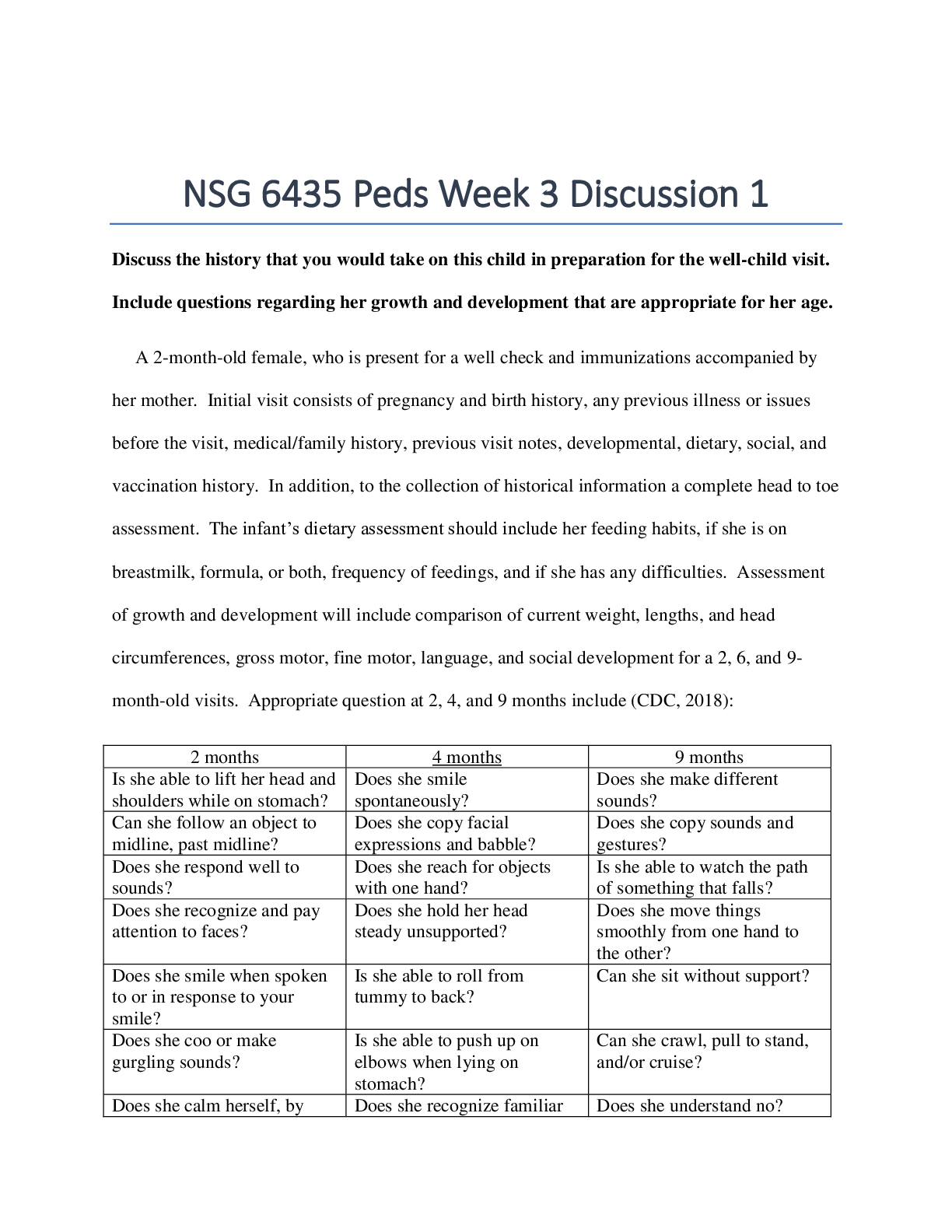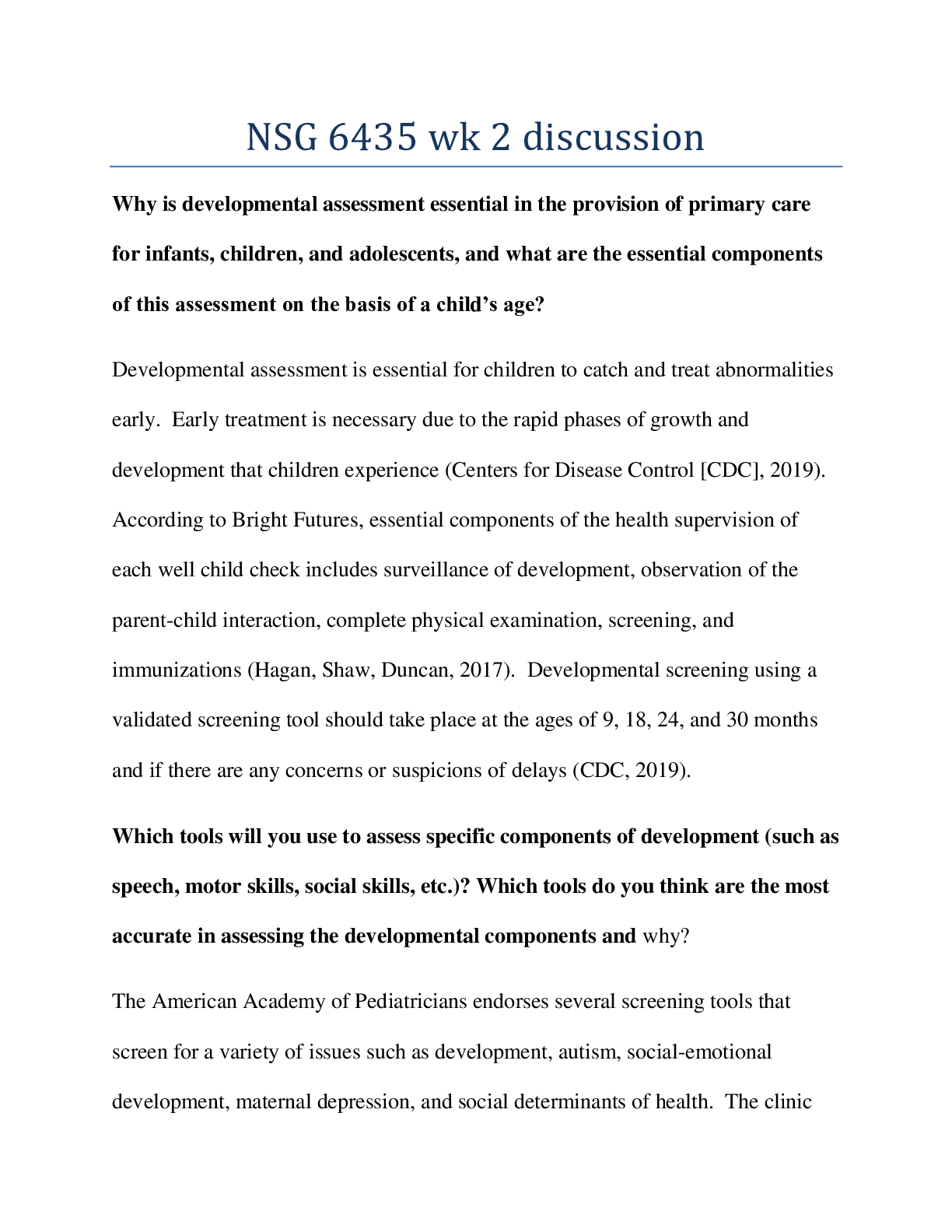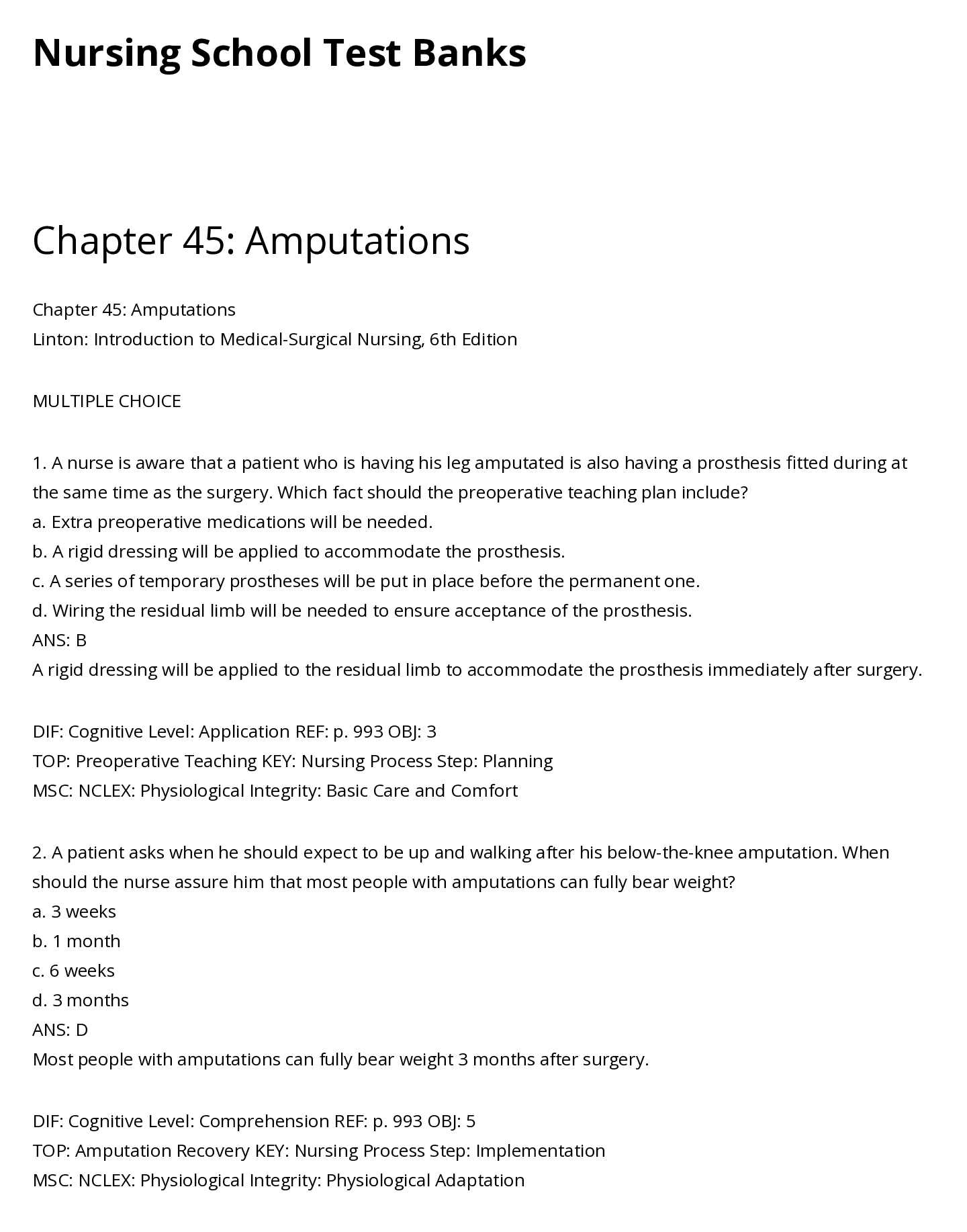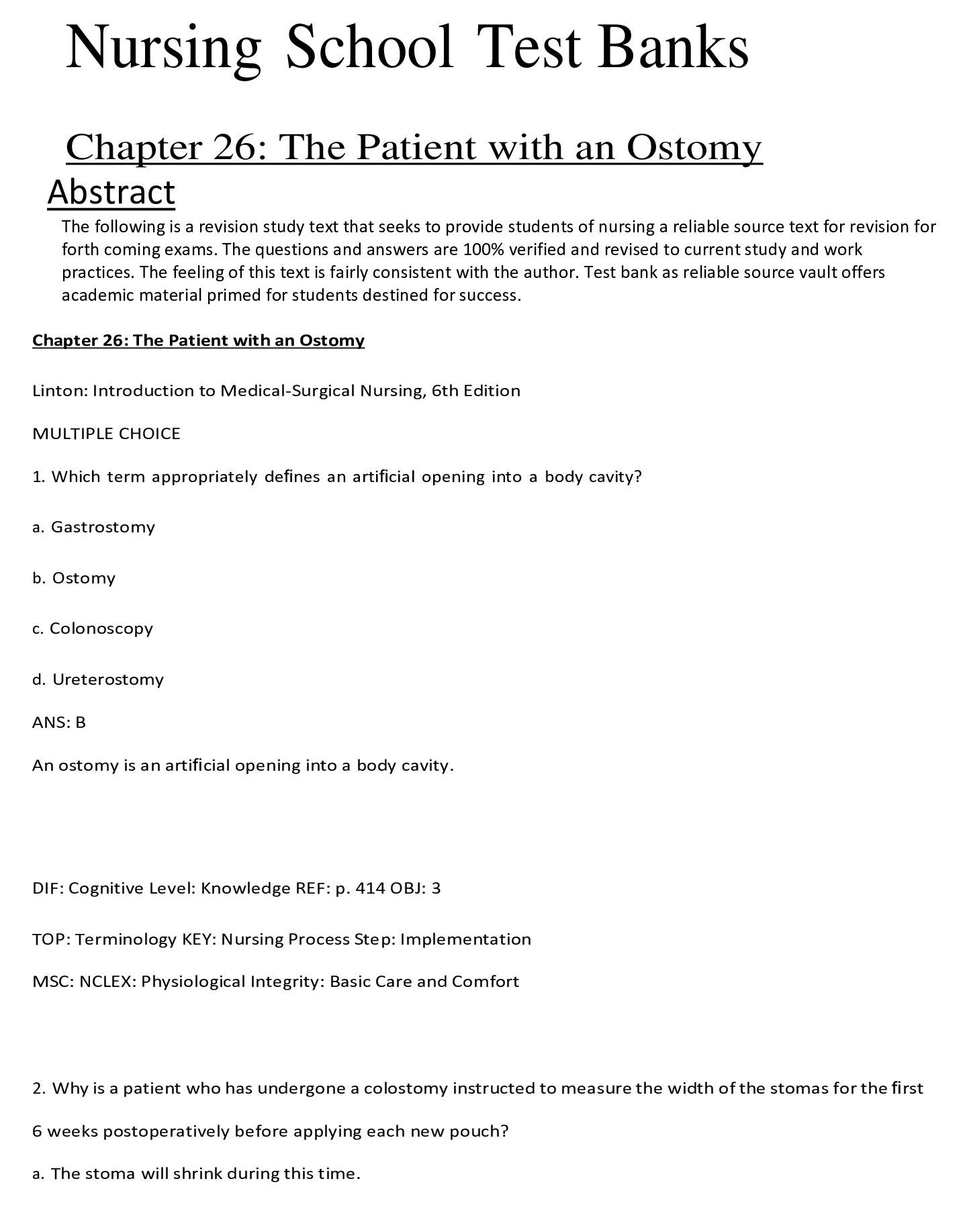*NURSING > QUESTIONS & ANSWERS > Marine Environmental Science (Indian River State College) Test 3 N4 Mod 7 Hinkle 23 - Review Materia (All)
Marine Environmental Science (Indian River State College) Test 3 N4 Mod 7 Hinkle 23 - Review Material Chapter 23 Nursing School Test Banks
Document Content and Description Below
A perioperative nurse is caring for a postoperative patient. The patient has a shallow respiratory pattern and is reluctant to cough or to begin mobilizing. The nurse should address the patients incre... ased risk for what 1. complication? A) Acute respiratory distress syndrome (ARDS) B) Atelectasis C) Aspiration D) Pulmonary embolism B 2. What should the nurse encourage the patient to do? A) Increase oral fluids unless contraindicated. B) Call the nurse for oral suctioning, as needed. C) Lie in a low Fowlers or supine position. D) Increase activity. A The public health nurse is administering Mantoux tests to children who are being registered for kindergarten in the 3. community. How should the nurse administer this test? A) Administer intradermal injections into the childrens inner forearms. B) Administer intramuscular injections into each childs vastus lateralis. C) Administer a subcutaneous injection into each childs umbilical area. D) Administer a subcutaneous injection at a 45-degree angle into each childs deltoid. A 4. The nurse is caring for a patient who has been in a motor vehicle accident and the care team suspects that the patien has developed pleurisy. Which of the nurses assessment findings would best corroborate this diagnosis? A) The patient is experiencing painless hemoptysis. B) The patients arterial blood gases (ABGs) are normal, but he demonstrates increased work of breathing. C) The patients oxygen saturation level is below 88%, but he denies shortness of breath. D) The patients pain intensifies when he coughs or takes a deep breath. D The nurse caring for a patient recently diagnosed with lung disease encourages the patient not to smoke. What is th 5. primary rationale behind this nursing action? A) Smoking decreases the amount of mucus production. B) Smoke particles compete for binding sites on hemoglobin. C) Smoking causes atrophy of the alveoli. D) Smoking damages the ciliary cleansing mechanism. D A patient has been brought to the ED by the paramedics. The patient is suspected of having ARDS. What 6. intervention should the nurse first anticipate? A) Preparing to assist with intubating the patient B) Setting up oxygen at 5 L/minute by nasal cannula C) Performing deep suctioning D) Setting up a nebulizer to administer corticosteroids A 7. Further assessment findings supporting the presence of a pneumothorax include what? A) Diminished or absent breath sounds on the affected side B) Paradoxical chest wall movement with respirations C) Sudden loss of consciousness D) Muffled heart sounds A 8. should the nurse teach the client? A) Coumadin will continue to break up the clot over a period of weeks B) Coumadin must be taken concurrent with ASA to achieve anticoagulation. C) Anticoagulant therapy usually lasts between 3 and 6 months. D) He should take a vitamin supplement containing vitamin K C 9. Which statement by the nurse will decrease the patients exposure risk to toxic substances? A) Position a fan blowing on the toxic substances to prevent the substance from becoming stagnant in the air. B) Wear protective attire and devices when working with a toxic substance. C) Make sure that you keep your immunizations up to date to prevent respiratory diseases resulting from D) toxin E) Always wear a disposable paper face mask when you are working with inhalable toxins. B An x-ray of a trauma patient reveals rib fractures and the patient is diagnosed with a small flail chest injury. Whic 10. intervention should the nurse include in the patients plan of care? A) Suction the patients airway secretions. B) Immobilize the ribs with an abdominal binder. C) Prepare the patient for surgery. D) Immediately sedate and intubate the patient. A The nurse is caring for a patient who is receiving oxygen therapy for pneumonia. How should the nurse best asses 11. whether the patient is hypoxemic? A) Assess the patients level of consciousness (LOC). B) Assess the patients extremities for signs of cyanosis. C) Assess the patients oxygen saturation level. D) Review the patients hemoglobin, hematocrit, and red blood cell levels. C An adult patient has tested positive for tuberculosis (TB). While providing patient teaching, what information 12. should the nurse prioritize? A) The importance of adhering closely to the prescribed medication regimen B) The fact that the disease is a lifelong, chronic condition that will affect ADLs C) The fact that TB is self-limiting, but can take up to 2 years to resolve D) The need to work closely with the occupational and physical therapists A The nurse is assessing an adult patient following a motor vehicle accident. The nurse observes that the patient has an increased use of accessory muscles and is complaining of chest pain and shortness of breath. The nurse should 13. recognize the possibility of what condition? A) Pneumothorax B) Anxiety C) Acute bronchitis D) Aspiration A The nurse at a long-term care facility is assessing each of the residents. Which resident most likely faces the 14. greatest risk for aspiration? A) A resident who suffered a severe stroke several weeks ago B) A resident with mid-stage Alzheimers disease C) A 92-year-old resident who needs extensive help with ADLs D) A resident with severe and deforming rheumatoid arthritis A The nurse is caring for a patient suspected of having ARDS. What is the most likely diagnostic test ordered in the 15. early stages of this disease to differentiate the patients symptoms from those of a cardiac etiology? A) Carboxyhemoglobin level B) Brain natriuretic peptide (BNP) level C) C-reactive protein (CRP) level D) Complete blood count B The nurse is caring for a patient at risk for atelectasis. The nurse implements a first-line measure to prevent 16. atelectasis development in the patient. What is an example of a first-line measure to minimize atelectasis? A) Incentive spirometry B) Intermittent positive-pressure breathing (IPPB) C) Positive end-expiratory pressure (PEEP) D) Bronchoscopy A While planning a patients care, the nurse identifies nursing actions to minimize the patients pleuritic pain. Which 17. intervention should the nurse include in the plan of care? A) Avoid actions that will cause the patient to breathe deeply. B) Ambulate the patient at least three times daily. C) Arrange for a soft-textured diet and increased fluid intake. D) Encourage the patient to speak as little as possible A The perioperative nurse is writing a care plan for a patient who has returned from surgery 2 hours prior. Which 18. measure should the nurse implement to most decrease the patients risk of developing pulmonary emboli (PE)? A) Early ambulation B) Increased dietary intake of protein C) Maintaining the patient in a supine position D) Administering aspirin with warfarin A A client presents to the walk-in clinic complaining of a dry, irritating cough and production of a minute amount o mucus-like sputum. The patient complains of soreness in her chest in the sternal area. The nurse should suspect th 21. the primary care provider will assess the patient for what health problem? A) Pleural effusion B) Pulmonary embolism C) Tracheobronchitis D) Tuberculosis C A hospital has been the site of an increased incidence of hospital-acquired pneumonia (HAP). What is an importa 22. measure for the prevention of HAP? A) Administration of prophylactic antibiotics B) Administration of pneumococcal vaccine to vulnerable individuals C) Obtaining culture and sensitivity swabs from all newly admitted patients D) Administration of antiretroviral medications to patients over age 65 B A patient presents to the ED stating she was in a boating accident about 3 hours ago. Now the patient has complaints of headache, fatigue, and the feeling that he just cant breathe enough. The nurse notes that the patient restless and tachycardic with an elevated blood pressure. This patient may be in the early stages of what respirato 24. problem? A) Pneumoconiosis B) Pleural effusion C) Acute respiratory failure D) Pneumonia C The nurse is caring for a 46-year-old patient recently diagnosed with the early stages of lung cancer. The nurse is 25. aware that the preferred method of treating patients with nonsmall cell tumors is what? A) Chemotherapy B) Radiation C) Surgical resection D) Bronchoscopic opening of the airway C A patient is receiving thrombolytic therapy for the treatment of pulmonary emboli. What is the best way for the 26. nurse to assess the patients oxygenation status at the bedside? A) Obtain serial ABG samples. B) Monitor pulse oximetry readings. C) Test pulmonary function. D) Monitor incentive spirometry volumes. B The nurse is caring for an 82-year-old patient with a diagnosis of tracheobronchitis. The patient begins complaining of right-sided chest pain that gets worse when he coughs or breathes deeply. Vital signs are within normal limits. 27. What would you suspect this patient is experiencing? A) Traumatic pneumothorax B) Empyema C) Pleuritic pain D) Myocardial infarction C A patient with thoracic trauma is admitted to the ICU. The nurse notes the patients chest and neck are swollen an there is a crackling sensation when palpated. The nurse consequently identifies the presence of subcutaneous 28. emphysema. If this condition becomes severe and threatens airway patency, what intervention is indicated? A) A chest tube B) A tracheostomy C) An endotracheal tube D) A feeding tube B The nurse is caring for a patient in the ICU admitted with ARDS after exposure to toxic fumes from a hazardous 29. spill at work. The patient has become hypotensive. What is the cause of this complication to the ARDS treatment A) Pulmonary hypotension due to decreased cardiac output B) Severe and progressive pulmonary hypertension C) Hypovolemia secondary to leakage of fluid into the interstitial spaces D) Increased cardiac output from high levels of PEEP therapy C The home care nurse is monitoring a patient discharged home after resolution of a pulmonary embolus. For what 30. potential complication would the home care nurse be most closely monitoring this patient? A) Signs and symptoms of pulmonary infection B) Swallowing ability and signs of aspiration C) Activity level and role performance D) Residual effects of compromised oxygenation D The occupational health nurse is assessing new employees at a company. What would be important to assess in 31. employees with a potential occupational respiratory exposure to a toxin? Select all that apply. A) Time frame of exposure B) Type of respiratory protection used C) Immunization status D) Breath sounds E) Intensity of exposure A, B, D, E A 54-year-old man has just been diagnosed with small cell lung cancer. The patient asks the nurse why the doctor is not offering surgery as a treatment for his cancer. What fact about lung cancer treatment should inform the 32. nurses response? A) The cells in small cell cancer of the lung are not large enough to visualize in surgery. B) Small cell lung cancer is self-limiting in many patients and surgery should be delayed. C) Patients with small cell lung cancer are not normally stable enough to survive surgery. D) Small cell cancer of the lung grows rapidly and metastasizes early and extensively. D 33. A patient is brought to the ED by ambulance after a motor vehicle accident in which the patient received blunt trauma to the chest. The patient is in acute respiratory failure, is intubated, and is transferred to the ICU. What 34. parameters of care should the nurse monitor most closely? Select all that apply. A) Coping B) Level of consciousness C) Oral intake D) Arterial blood gases E) Vital signs B, D, E A gerontologic nurse is teaching a group of medical nurses about the high incidence and mortality of pneumonia in 35. older adults. What is a contributing factor to this that the nurse should describe? A) Older adults have less compliant lung tissue than younger adults. B) Older adults are not normally candidates for pneumococcal vaccination. C) Older adults often lack the classic signs and symptoms of pneumonia. D) Older adults often cannot tolerate the most common antibiotics used to treat pneumonia. C A patient has just been diagnosed with lung cancer. After the physician discusses treatment options and leaves the 36. room, the patient asks the nurse how the treatment is decided upon. What would be the nurses best response? A) The type of treatment depends on the patients age and health status. B) The type of treatment depends on what the patient wants when given the options. The type of treatment depends on the cell type of the cancer, the stage of the cancer, and the patients heal C) status. The type of treatment depends on the discussion between the patient and the physician of which treatment D) is best. C A patient in the ICU is status post embolectomy after a pulmonary embolus. What assessment parameter does the 37. nurse monitor most closely on a patient who is postoperative following an embolectomy? A) Pupillary response B) Pressure in the vena cava C) White blood cell differential D) Pulmonary arterial pressure D A firefighter was trapped in a fire and is admitted to the ICU for smoke inhalation. After 12 hours, the firefighter 38. exhibiting signs of ARDS and is intubated. What other supportive measures are initiated in a patient with ARDS? A) Psychological counseling B) Nutritional support C) High-protein oral diet D) Occupational therapy B The nurse is reviewing the electronic health record of a patient with an empyema. What health problem in the 39. patients history is most likely to have caused the empyema? A) Smoking B) Asbestosis C) Pneumonia D) Lung cancer C An 87-year-old patient has been hospitalized with pneumonia. Which nursing action would be a priority in this 40. patients plan of care? A) Nasogastric intubation B) Administration of probiotic supplements C) Bedrest D) Cautious hydration D . [Show More]
Last updated: 2 years ago
Preview 1 out of 12 pages
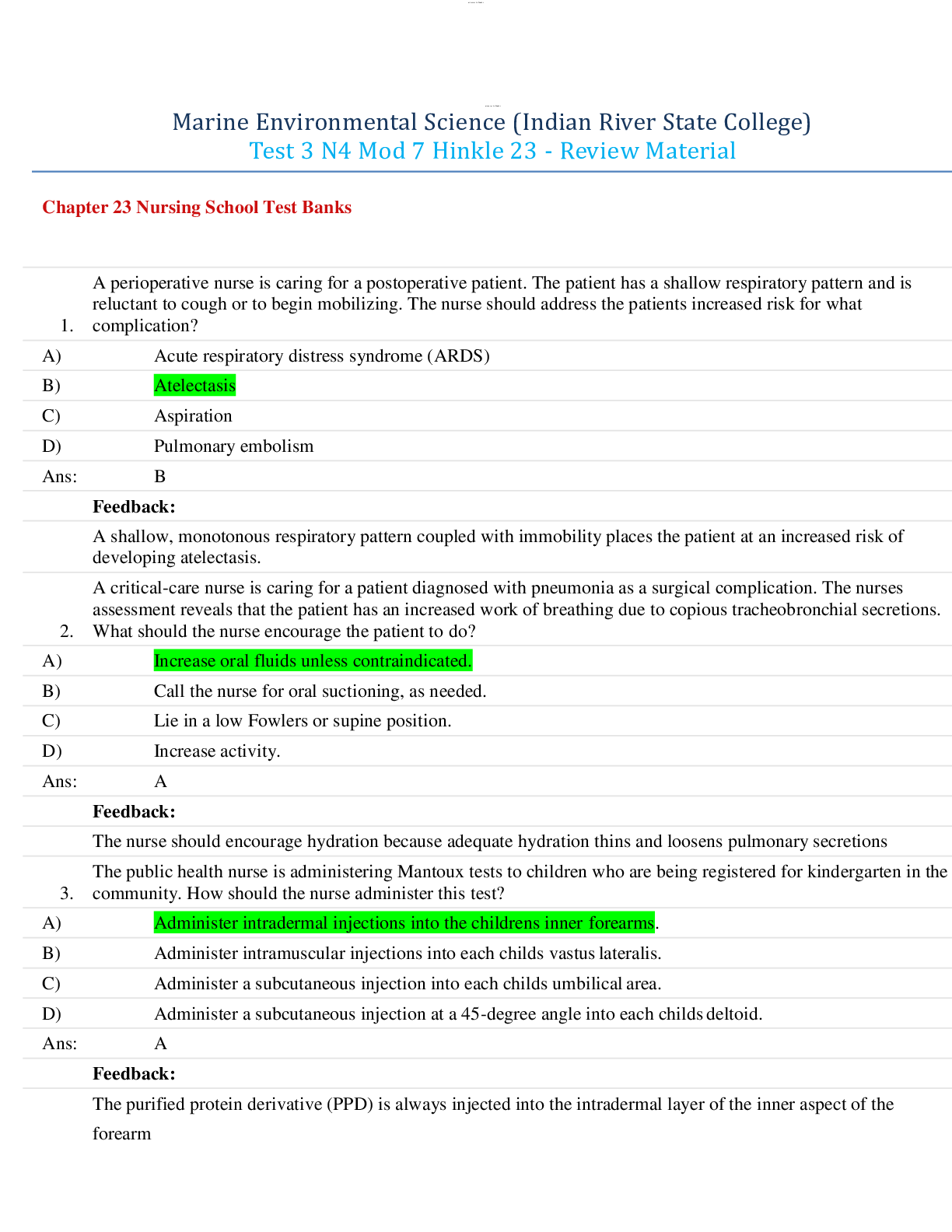
Buy this document to get the full access instantly
Instant Download Access after purchase
Buy NowInstant download
We Accept:

Reviews( 0 )
$9.00
Can't find what you want? Try our AI powered Search
Document information
Connected school, study & course
About the document
Uploaded On
Jul 02, 2020
Number of pages
12
Written in
Additional information
This document has been written for:
Uploaded
Jul 02, 2020
Downloads
0
Views
94

